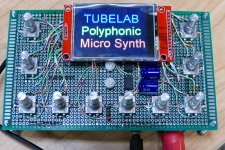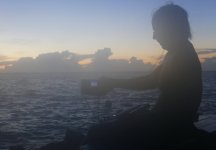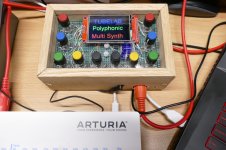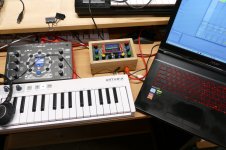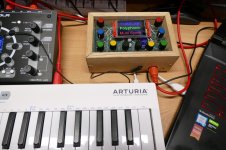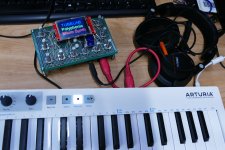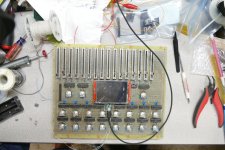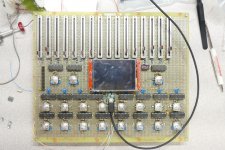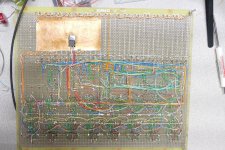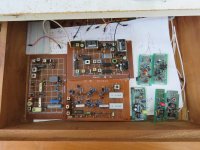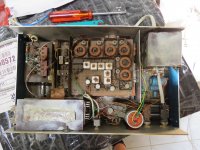Back in post #156 I showed Blue, my perf board "analog emulation" music synthesizer. Blue sounds great, and does a decent job of emulating an analog synth, right down to the box full of pots front panel.
The front panel is great for live situations if you like to twiddle knobs, since each function has its own knob, and each knob does exactly one thing, like filter cutoff, or attack time.
There are a few major drawbacks to this though. The first is size. Blue has 51 knobs. Knobs take up space, and they are not cheap either. The biggest drawback is the lack of ability to save anything. Lets say that you spend two days twisting knobs to make exactly the nifty sound that you need for a project. Then you need to make a different sound. How to you get back to the first one, especially in my case since I never made an overlay with numbers on it. I have resorted to taking pictures of the knobs.
There is the other extreme. You only have two hands, so you can only turn two knobs at once, so why have more than two on the front panel? Place two knobs, and use a menu system to allow for changing every parameter in the synth. Anyone who has ever gone down this path knows just how much that sucks. You might need to dive down through 5 layers of menus just to boost the bass a little. I have a tiny synth that has no knobs. All adjustments must be made with a PC. Small, but doesn't see nearly any use.
There is a lot of space in between these extremes, and the sweet spot depends on how the machine, whatever it is, will be used.
About 3 weeks before a Florida vacation last September, I decided to take my best shot at a small synth that was highly portable, and could be used without a computer. I only had 3 weeks, so it was made on perf board and thrown together too fast, so that I had to add a second board to fit everything. It was to be an exercise in "how many polyphonic synthesizers can I stuff into a Teensy 4.1 module before it runs out of memory, or CPU power."
I started with the concept behind Blue, ripped out voltage control, cut out one of the VCO's, and made the signal path monophonic (one VCF, VCA, and ADSR). The tiny synth is MIDI input only. I put 6 copies of the remaining code in place, and had a 6 voices, and 50% of memory and 80% of CPU power left, so I stuffed in a 6 voice Karplus Strong synth, and some basic drums. The user interface consisted of 10 rotary encoders and a small touch screen. Much of the code to run the UI is still in flux.
I got this thing together and working just as we left on our road trip, and was writing code while Sherri was driving south. I had plans to make a Youtube video or three of me playing with this thing on the beach with a small Keystep sequencer / keyboard, an NDLR, and Ableton Live on a laptop. Unfortunately Hurricane Sally formed right on top of us, which trashed those plans, and much of the island we were staying on.
I did take the small synth and the Keystep out in the weather twice before it got too bad. No live music was recorded. Letting a $99 keyboard and a rebuildable synth get wet is one thing, but the $1K laptop, and $700 camera stayed in their cases.
I have a couple pictures of the synth before I made the wood case, and a few after. There is one picture of me playing it on the dock in a light rain. I made a video of this, but had no way to record sound.
The calm before the hurricane - no music, just the surf, the wind and the birds - YouTube
The front panel is great for live situations if you like to twiddle knobs, since each function has its own knob, and each knob does exactly one thing, like filter cutoff, or attack time.
There are a few major drawbacks to this though. The first is size. Blue has 51 knobs. Knobs take up space, and they are not cheap either. The biggest drawback is the lack of ability to save anything. Lets say that you spend two days twisting knobs to make exactly the nifty sound that you need for a project. Then you need to make a different sound. How to you get back to the first one, especially in my case since I never made an overlay with numbers on it. I have resorted to taking pictures of the knobs.
There is the other extreme. You only have two hands, so you can only turn two knobs at once, so why have more than two on the front panel? Place two knobs, and use a menu system to allow for changing every parameter in the synth. Anyone who has ever gone down this path knows just how much that sucks. You might need to dive down through 5 layers of menus just to boost the bass a little. I have a tiny synth that has no knobs. All adjustments must be made with a PC. Small, but doesn't see nearly any use.
There is a lot of space in between these extremes, and the sweet spot depends on how the machine, whatever it is, will be used.
About 3 weeks before a Florida vacation last September, I decided to take my best shot at a small synth that was highly portable, and could be used without a computer. I only had 3 weeks, so it was made on perf board and thrown together too fast, so that I had to add a second board to fit everything. It was to be an exercise in "how many polyphonic synthesizers can I stuff into a Teensy 4.1 module before it runs out of memory, or CPU power."
I started with the concept behind Blue, ripped out voltage control, cut out one of the VCO's, and made the signal path monophonic (one VCF, VCA, and ADSR). The tiny synth is MIDI input only. I put 6 copies of the remaining code in place, and had a 6 voices, and 50% of memory and 80% of CPU power left, so I stuffed in a 6 voice Karplus Strong synth, and some basic drums. The user interface consisted of 10 rotary encoders and a small touch screen. Much of the code to run the UI is still in flux.
I got this thing together and working just as we left on our road trip, and was writing code while Sherri was driving south. I had plans to make a Youtube video or three of me playing with this thing on the beach with a small Keystep sequencer / keyboard, an NDLR, and Ableton Live on a laptop. Unfortunately Hurricane Sally formed right on top of us, which trashed those plans, and much of the island we were staying on.
I did take the small synth and the Keystep out in the weather twice before it got too bad. No live music was recorded. Letting a $99 keyboard and a rebuildable synth get wet is one thing, but the $1K laptop, and $700 camera stayed in their cases.
I have a couple pictures of the synth before I made the wood case, and a few after. There is one picture of me playing it on the dock in a light rain. I made a video of this, but had no way to record sound.
The calm before the hurricane - no music, just the surf, the wind and the birds - YouTube
Attachments
Back in posts #41 and #47 I showed and discussed some perf board building blocks for a digital music synthesizer that I built in 1971 and 1972. It was large and took up much of an old organ cabinet as well as extending a couple feet upwards on top of it. Unfortunate personal circumstances prevented it's completion and lead to it's destruction. I left home, got a job at Motorola in 1973 where I stayed until 2014. I made enough $$$ to simply buy some ARP and Korg stuff and forgot about the old project. Unfortunately I was stupid enough to sell all that neat old analog stuff at the low point in its resale value, sometime in the digital 90's.
I had been randomly dreaming about rebuilding or even trying to power up those old boards, but those dreams faded before any serious action occurred......until recently.
A few years back I started down the Eurorack modular synth rabbit hole and now have a rack full of "modules," some analog, some digital, and some just complete Behringer clone synths. It's neat, but not very practical to take on road trips.
Almost 3 years ago I decided to make Blue, a somewhat portable synth, made on perf board along with the box PC, a similarly sized core i7 PC capable of running DAW software, operating the synth, and recording it's output. Blue and the PC can be seen in the pictures in post #156.
Blue was somewhat portable, but the PC got broken on another trip, so I made the tiny polyphonic micro synth last year. Again a perf board design. Both are just sound modules with rather imperfect UI's. They both mesh well with my modular synth under DAW control, which now resides in a pricey gaming laptop.
Still I wanted a complete music factory in a single reasonably small stand alone box capable of battery operation. So after I returned from a road trip in September last year I started down the path toward a full blown music system, multi level sequencer, simple multi level UI, and several synths, both analog and digital. It should be able to function stand alone, be able to interface with a DAW, in a PC, and be a part of an expanded DAWless system (no computer). The target size is about 10 X 12 inches by about 2.5 inches thick.
I have wired up about 80% of the first board, which does the UI and sequencing. It contains 21 microprocessors, 19 rotary encoders, 16 slide pots, and a 3.2 inch touch screen. Testing and code writing is in progress.
Once I'm happy with this board, I will build the synth engine board.
I had been randomly dreaming about rebuilding or even trying to power up those old boards, but those dreams faded before any serious action occurred......until recently.
A few years back I started down the Eurorack modular synth rabbit hole and now have a rack full of "modules," some analog, some digital, and some just complete Behringer clone synths. It's neat, but not very practical to take on road trips.
Almost 3 years ago I decided to make Blue, a somewhat portable synth, made on perf board along with the box PC, a similarly sized core i7 PC capable of running DAW software, operating the synth, and recording it's output. Blue and the PC can be seen in the pictures in post #156.
Blue was somewhat portable, but the PC got broken on another trip, so I made the tiny polyphonic micro synth last year. Again a perf board design. Both are just sound modules with rather imperfect UI's. They both mesh well with my modular synth under DAW control, which now resides in a pricey gaming laptop.
Still I wanted a complete music factory in a single reasonably small stand alone box capable of battery operation. So after I returned from a road trip in September last year I started down the path toward a full blown music system, multi level sequencer, simple multi level UI, and several synths, both analog and digital. It should be able to function stand alone, be able to interface with a DAW, in a PC, and be a part of an expanded DAWless system (no computer). The target size is about 10 X 12 inches by about 2.5 inches thick.
I have wired up about 80% of the first board, which does the UI and sequencing. It contains 21 microprocessors, 19 rotary encoders, 16 slide pots, and a 3.2 inch touch screen. Testing and code writing is in progress.
Once I'm happy with this board, I will build the synth engine board.
Attachments
Interesting thread. A few of the RF projects I've been working on, in this pic. Dual conversion 10.7 IF and active antenna (RX) amps (green epoxy).
BTW the brown perf board doesn't contrast well with any component or wire. Who knows if and where white perf board is sold?
BTW the brown perf board doesn't contrast well with any component or wire. Who knows if and where white perf board is sold?
Attachments
There is this stuff, but it's pricey and not exactly what I would want, but may be useful for some small stuff:
Adafruit Perma-Proto Full-sized Breadboard PCB - 3 Pack! : ID 590 : $19.95 : Adafruit Industries, Unique & fun DIY electronics and kits
Found these on Ebay:
8 Pcs (7x9cm) Double Sided PCB Board Prototype Kit Soldering 5 Colour Universal | eBay
3x Double Side Stripes Prototype PCB Printed Circuit Boards DIY Proto Breadboard | eBay
Sparkfun has some red stuff:
ProtoBoard - Wombat (PTH) - PRT-08619 - SparkFun Electronics
SparkFun Snappable Protoboard - PRT-13268 - SparkFun Electronics
The blue stuff that I had (front panel of Blue) was found at a hamfest at least 20 years ago as part of a DIY wire wrapping kit that contained lots of colored wire wrap wire, a wrap gun and lots of DIP sockets.
The large Vector boards seen in my last post were also hamfest scores. They are still available, but way beyond expensive at $62 each.
https://www.digikey.com/en/products/detail/vector-electronics/8012/146827?
Most of my current projects use the same green Chinese stuff that you are using. I get is from Amazon or Ebay
Adafruit Perma-Proto Full-sized Breadboard PCB - 3 Pack! : ID 590 : $19.95 : Adafruit Industries, Unique & fun DIY electronics and kits
Found these on Ebay:
8 Pcs (7x9cm) Double Sided PCB Board Prototype Kit Soldering 5 Colour Universal | eBay
3x Double Side Stripes Prototype PCB Printed Circuit Boards DIY Proto Breadboard | eBay
Sparkfun has some red stuff:
ProtoBoard - Wombat (PTH) - PRT-08619 - SparkFun Electronics
SparkFun Snappable Protoboard - PRT-13268 - SparkFun Electronics
The blue stuff that I had (front panel of Blue) was found at a hamfest at least 20 years ago as part of a DIY wire wrapping kit that contained lots of colored wire wrap wire, a wrap gun and lots of DIP sockets.
The large Vector boards seen in my last post were also hamfest scores. They are still available, but way beyond expensive at $62 each.
https://www.digikey.com/en/products/detail/vector-electronics/8012/146827?
Most of my current projects use the same green Chinese stuff that you are using. I get is from Amazon or Ebay
Thanks very much for the links, boards with light colors is what I used to work with. As a rule my hobby activity was more complicated than that for the job so contrast with wiring and components, major issue. When a hobby project finally was working "as should according to calculation / simulation" it never was turned into a printed circuit. One example from 1976 
Attachments
- Home
- General Interest
- Everything Else
- Post Pictures of Your Vero Board Designs Here.
